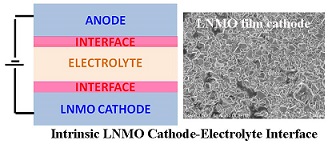

高电压镍锰酸锂正极/电解液界面本征性质的研究
收稿日期: 2016-06-16
修回日期: 2016-07-27
网络出版日期: 2016-07-29
基金资助
国家自然科学基金项目(21473241,21273273和21503265), 苏州市科技计划项目(ZXG201419)资助.
Intrinsic Interfacial Property between High-Voltage LiNi0.5Mn1.5O4 Cathode and Electrolyte
Received date: 2016-06-16
Revised date: 2016-07-27
Online published: 2016-07-29
高电压正极材料的应用是提高锂离子电池能量密度的有效手段,然而高电压下正极/电解液界面稳定性成为决定锂离子电池在高电压工作条件下循环性能和安全性能的关键因素,因此高电压下正极/电解液界面具有重要的研究价值. 但是,目前报道的正极/电解液界面的研究中通常使用传统的极片制备方法,这需要引入导电剂和粘结剂,会对后期正极活性物质表面钝化膜的形貌和组分表征带来干扰,甚至造成固体电解质界面(SEI)膜存在的假象,难以获得正极材料与电解液之间界面的本征信息. 这里,我们采用溶胶凝胶旋涂法制备了不含导电剂和粘结剂的镍锰酸锂(LNMO)正极,以其为研究对象,通过扫描电镜(SEM)、原子力显微镜(AFM)和X射线光电子能谱(XPS)技术,结合电化学阻抗谱(EIS)研究了LNMO正极/电解液界面在充放电过程中的结构演变过程以及本征性质. 研究结果显示在充放电过程中,电解液中溶剂和电解质都会参与反应,其中LiPF6的降解主要发生在高电压下,其降解产物在放电过程中又会被反应消耗掉. 它们的降解产物沉积到LNMO正极形成表面膜,该表面膜的主要成分随着电压的不同组分有所不同.

李丽,许晶晶,韩少杰,吴晓东,卢威,陈立桅 . 高电压镍锰酸锂正极/电解液界面本征性质的研究[J]. 电化学, 2016 , 22(6) : 582 -589 . DOI: 10.13208/j.electrochem.160564
To obtain high energy density, developing high-voltage cathode materials is an effective approach. The cathode/electrolyte interface stability is the key factor for the cycle performance and safety performance of high-voltage lithium ion batteries. It is, therefore, of significant importance to study the stability of cathode/electrolyte interface. However, many reports have shown that at the cathode/electrolyte interface the cathodes were prepared by coating the mixture of active materials with a conductive additive and a binder on an Al current collector. The introduction of additives will interfere the surface morphology and component analyses, resulting in difficulty to acquire the intrinsic information at the cathode/electrolyte interface. In this paper, the LiNi0.5Mn1.5O4 (LNMO) film electrodes were prepared via sol-gel method without using conductive additive and binder. The surface morphology and the intrinsic property of LNMO electrode/electrolyte interface during the charge/discharge process were studied by scanning electron microscopy (SEM), atomic force microscopy (AFM), X-ray photoelectron spectroscopy (XPS) and Electrochemical impedance spectroscopy (EIS). The results demonstrated that both solvents and LiPF6 salt degraded during the charge/discharge process. The degradation of LiPF6 mainly happened at the high-voltage charge process and the intermediate POF3 was unstable which continued to be reacted during the discharge process. The degraded residues deposit on the surface of LNMO cathode to form a surface film and the compositions of the surface film varied with voltages during the electrochemical process.

/
| 〈 |
|
〉 |